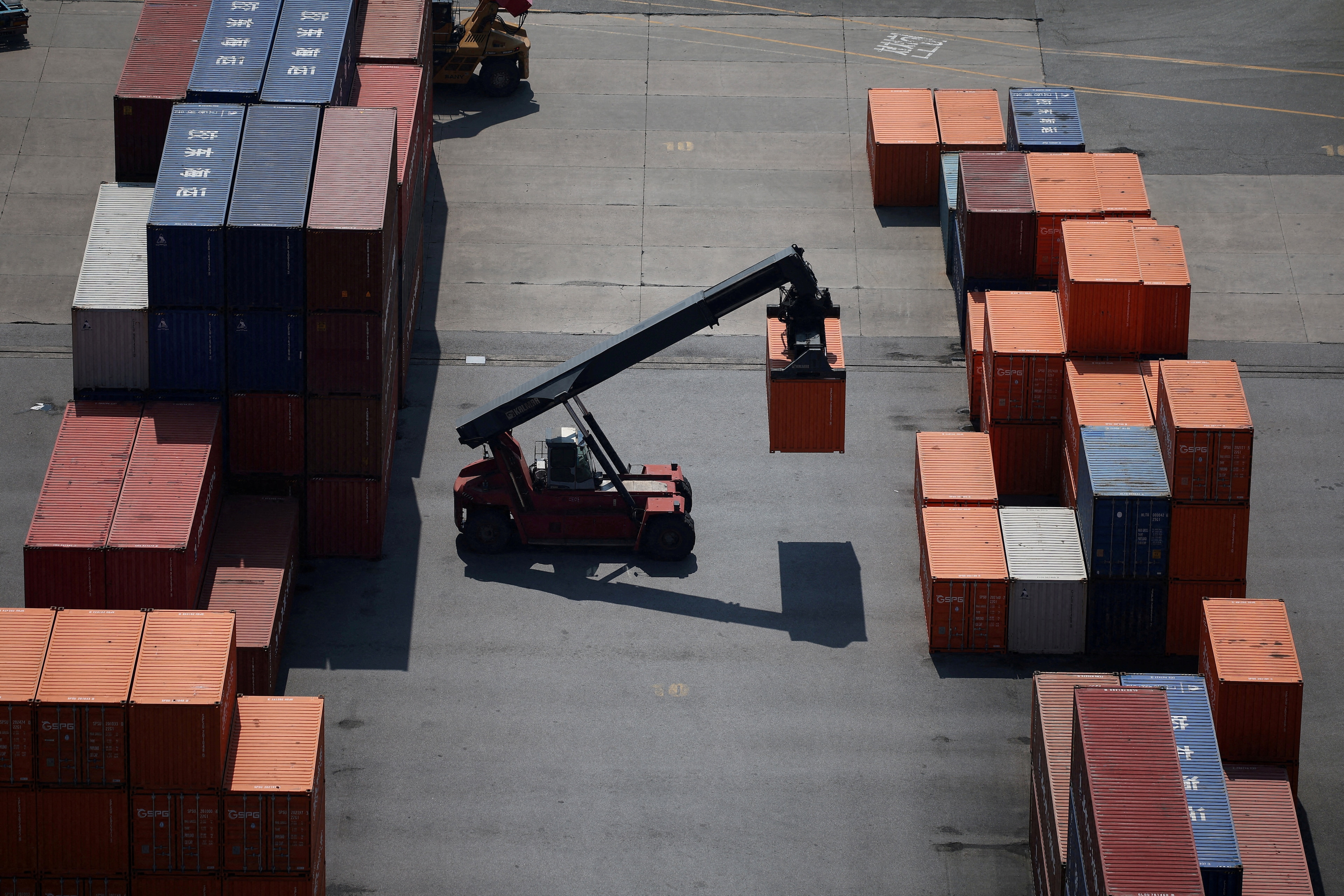Why paytech is the key to unlocking Africa's new free trade zone

AfCFTA could raise the incomes of nearly 100 million across the continent – with paytech's help.
Image: Reuters/Philimon Bulawayo
Stay up to date:
The Digital Economy
- Efficient payment will be needed across the AfCFTA's 55 countries, with their varying financial system.
- Africa's emerging paytech sector already has experience working across borders.
- Government-sanctioned paytech is a better trade facilitation option than unregulated cryptocurrencies.
Optimistic, the world holds its breath for the African Continental Free Trade Agreement (AfCFTA) as it seeks to redefine African markets. It will create uniform rules to guide trade, dispute settlement, investments, competition and intellectual property rights across the continent.
According to the World Bank, AfCFTA will lift 30 million people out of extreme poverty and raise the incomes of 68 million more. Intra-African trade was around 2% of the continent’s total trade between 2015 and 2017, while comparative figures for America, Asia, Europe and Oceania were, respectively, 47%, 61%, 67% and 7%. The goal of Africa’s new trade pact is to increase this share within the world’s largest free trade area (in terms of numbers of countries).
However, with the AfCFTA signed, implementation is the next critical hurdle. In the words of its Secretary-General Wamkele Mene: “We have completed the easiest part – that is for 55 countries to negotiate a single set of rules. The most difficult part is implementation.”
Payment has always been the lifeblood of trade, from the days of barter to cash and now electronic payment channels. The same is true for intra-African trade, which covers 55 countries with varying financial and monetary systems. Consequently, payment is critical on the list of items that will drive AfCFTA’s future success.
Having supercharged online commerce in many countries, Africa’s budding paytech sector offers a lot of promise. Africa boasts only a few billion-dollar companies, and paytech companies dominate this list: namely, Interswitch, Flutterwave and Fawry.
Flutterwave raised $170 million in funding just a few months after global payment network Stripe acquired Nigerian start-up Paystack for around $200 million in one of Africa's few large-scale buyouts in the tech sector so far. The continental trade agreement now presents an opportunity for paytech to go one further by bridging geographic and financial divides across the continent.
These recent investments have enabled expansions across the continent. Effectively, paytech companies already have a firm grasp of payments culture, infrastructure and policies in multiple countries. For example, SeerBit operates in nine countries, including Tanzania, Kenya and Ghana. Understanding these markets places paytech start-ups in a better position to facilitate the integration of the diverse markets into an efficient payment system for fluid trade.

However, the multiplicity of licensing regimes for payment service providers, including banks, is a potential hindrance for innovative payment services to support AfCFTA. To tackle this challenge, it is critical that a uniform regime similar to the e-money license in Europe be implemented. This allows licensed companies – or Electronic Money Institutions – to issue electronic money, facilitating payment transactions and payment services to consumers and businesses, and other payment service providers.
Already, the Pan-African Payments and Settlement System (PAPSS), a centralized payment and settlement infrastructure being developed for intra-African trade will provide the rails upon which some of these all-important cross-border paytech solutions could be developed.
PAPSS, developed in collaboration with the African Export-Import Bank (AFREXIM), will help reduce the turnaround time for settlement of payment for intra-African trade. It is expected to reduce cost, duration and time variability of cross-border payments; decrease liquidity requirements of commercial banks and central banks, and strengthen central banks’ oversight of cross-border payment systems.
The gradual implementation of the continental trade agreement will include the harmonization of regulations to create a common financial instrument and a transparent framework for payment integration among fragmented state markets.
Sitting outside the circle of regulatory oversight, however, cryptocurrencies are touted as an alternative practical solution to the challenge of timely and cheap cross-border payments in Africa. But the importance of the regulatory oversight and African governments’ disapproval or hesitation with cryptocurrencies casts a shadow over this option.
The success of continent-spanning global actors like Amazon and Uber show the clear need for digital technology to take an international, rather than national or continental, approach.
”Paytech, built on government-sanctioned financial systems, remains the most viable way to drive intra-African trade. Nonetheless, blockchain technology, which underpins crypto and confers advantages like lower costs and faster transactions, could prove a game changer if layered on top of government-sanctioned systems. In fact, some African countries are already working to launch digital currencies leveraging blockchain; if interoperability is designed into these systems, they hold massive potential.
Accordingly, innovators need to be mindful of certain factors for success. First, for paytech to help AfCFTA reach its full potential, it is important for cross-border payment innovations to be inclusive by recognizing Africa’s largely offline population. Financial technology innovations in Africa heavily favour mobile internet users because of considerable growth in this sector. However, the majority are still not online: Internet penetration in Africa stood at 40% as of 2019, with countries like Ethiopia currently having as low a share as 20.6%. Another angle is the volume of informal cross-border trade on the continent, which is heavily reliant on cash payments.
What is the World Economic Forum doing about digital trade?
It is prevalent in western and eastern Africa, accounting for as much as 42% and 80% respectively, of total trade between some countries in these regions. For the AfCFTA to properly capture informal cross-border trade and Africa’s largely offline population, payment solutions must devise offline options that bridge the gap. USSD, a non-internet mobile protocol that takes advantage of widespread mobile phone ownership, and agency banking, the use of widespread retail-agent outlets to process transactions, are good examples of such options.
Equally, payment innovations for AfCFTA should consider the world’s rapid globalization and the importance of connecting Africa’s payment systems to the rest of the world. A uniform set of trade rules has the potential to increase Africa’s share of global trade (currently standing at just 3%), and it is necessary for payments innovations to recognize this.
The success of continent-spanning global actors like Amazon and Uber show the clear need for digital technology to take an international, rather than national or continental, approach. By optimizing African payment systems for global trade, African businesses will be empowered to transact and expand globally.
What is the World Economic Forum doing on trade facilitation?
While the implementation of AfCFTA goes up a gear, paytech is poised to take intra-African and even Africa’s global trade to the next level. Therefore, innovation in the sector, along with favourable regulatory policies, are now paramount to make transportation of capital throughout Africa efficient, seamless and instantaneous.
Don't miss any update on this topic
Create a free account and access your personalized content collection with our latest publications and analyses.
License and Republishing
World Economic Forum articles may be republished in accordance with the Creative Commons Attribution-NonCommercial-NoDerivatives 4.0 International Public License, and in accordance with our Terms of Use.
The views expressed in this article are those of the author alone and not the World Economic Forum.
Forum Stories newsletter
Bringing you weekly curated insights and analysis on the global issues that matter.
More on Trade and InvestmentSee all
Madeleine North
August 6, 2025
JJ Enoch
August 6, 2025
Spencer Feingold
July 30, 2025
Charlotte Edmond
July 30, 2025
John Letzing
July 24, 2025





